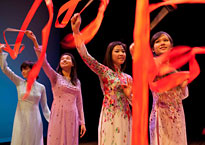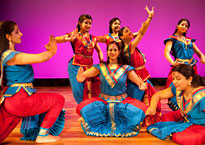Body Language
Five cultures, five dances, five stories
By Cynthia K. Buccini, Photographs by Asia Kepka
On a Friday night at the Tsai Performance Center, eight young women take the stage, wearing costumes in bright red and royal blue, cuffs with shiny bells strapped around their ankles, gold belts around their waists, and headpieces in the part of their hair.
They begin dancing in graceful, practiced unison, the bells tinkling with every stamp of their bare feet. The performance, by BU Dheem, the student classical Indian arts association, is adapted from the fairy tale The Red Shoes, only in this version the bells are bewitched by a demon.
“We soon realize that the bells have taken on a life of their own,” says Shivani Ray (CAS’12), vice president of BU Dheem. “They keep making us dance, even though we are getting more tired and pained. Finally, we get so tired, we fall to the floor and take our last breaths.” The performance is at once theater, music, and dance.
“One of the most wonderful things about Indian classical dance is that it spans thousands of years,” says Ray. “It’s full of rich culture, language, history, and traditions.”
BU Dheem is one of nearly 50 student cultural organizations at the University, from the African Students Organization to the West Indian Network. Many have their own dance groups, which practice regularly and perform several times a year at multicultural events on campus and at festivals or competitions in the city and out of state. The goal, students say, is to express themselves, showcase their talent, and share their culture.
Maureen Njung’e (CAS’13) is a member of the African Students Organization dance troupe AFRITHMS. “Instead of just telling the BU community about Africa,” she says, “we bring Africa to the BU community and show it through dance.”
Here, Bostonia highlights five of the University’s cultural dance groups: AFRITHMS, Boston Salsa University, BU Dheem, the Vietnamese Student Association, and X-Ception Step Team.














































 Twitter
Twitter Facebook
Facebook
Comments
On 17 September 2011 at 8:08 AM, Javad koohsar (MED/BUSM) wrote:
I like dance in college.
On 16 September 2011 at 12:41 PM, Laura Castro (COM'12) wrote:
I love all these groups! This is an awesome piece for Bostonia.
On 15 September 2011 at 8:31 PM, Kaja M. (GSM) wrote:
These series are great because they give people the opportunity to learn and experience cultures that they did not know about. The pictures and images are amazing. BU should definitely continue to do this more often by using its diverse students because there is still so much to tell and learn.
On 15 September 2011 at 1:33 PM, Katherine Kennedy wrote:
This series is one of the best features Bostonia has done. It is colorful, exciting and educational. It displays some of the best about BU. I love the layout and format. Thanks.
On 14 September 2011 at 12:17 PM, Kimberlee (SMG’14) wrote:
Wow! This is really cool! It makes me want to join a dance club!
On 14 September 2011 at 11:35 AM, Anonymous wrote:
Are there schedules for these groups somewhere?
On 13 September 2011 at 12:42 PM, nasim (CAS) wrote:
Beautiful
Post Your Comment